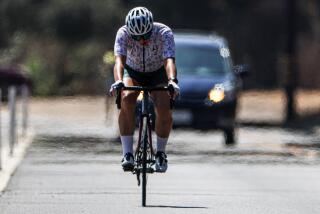S. D. Gasps and Gulps as Heat Goes On
- Share via
Electricity use soared to an all-time high and water consumption reached near capacity Tuesday as San Diego-area residents--their bodies and psyches brutalized by an unprecedented weekend heat wave--straggled back to the relative comfort of their air-conditioned offices and schoolrooms after the Labor Day break.
San Diego Gas & Electric Co. officials said that so many air conditioners and fans were turned on Tuesday that electricity use surged to a record 2,831 megawatts at 3:30 p.m. The previous record was 2,568 megawatts Aug. 26; a normal day’s use would be about 2,100 megawatts.
Appeared to Be Breaking
San Diego residents were also consuming so much water that pipes were carrying near-capacity volumes, prompting county water officials to issue a call for redoubled conservation measures.
The peak use in electricity and water came as the heat wave appeared to be breaking, according to National Weather Service figures. Unlike temperatures during the weekend, which set record highs for early September, Tuesday’s highs were relatively tame.
At Lindbergh Field, the high was 86, shy of the record 90 set in 1952, said weather service meteorologist Wilbur Shigehara.
Temperatures inland were dipping, too, he said. Poway, which registered highs of 104 and 105 over the weekend, dipped to an even 100 on Tuesday; Fallbrook recorded 101, down from Monday’s 106.
“We’ve passed the toughest part,” Shigehara said.
But he cautioned that the Santa Ana winds, which brought the record heat from the east, will now shift and carry uncomfortable humidity from the south. Clouds will gather in the mountains, and the county will be susceptible to thunderstorms.
“Although the heat wave is beginning to break, with the additional moisture it will still feel very, very warm,” Shigehara said. “For example, Lindbergh temperatures tomorrow will be down to 80 degrees, but it will still feel the same as today. It will feel like it is 5 degrees warmer.”
Shigehara said the slow cooling trend will continue today, with temperatures expected to reach 78 to 86 along the coast and 90 to 100 inland.
Although temperatures dipped Tuesday, San Diegans were still noticeably uncomfortable. On the first day of school, students at four campuses in the Grossmont Union High School District were sent home at noon because of the heat.
Elsewhere, air conditioners gobbled up the record amount of electricity to make workplaces and schoolrooms comfortable.
SDG&E; spokesmen attributed the record use, in part, to the fact that many office buildings, left empty over the weekend, retained a great deal of heat from the searing temperatures. Thus, when air conditioners kicked on early Tuesday to prepare for office workers, the cooling units were strained more than usual.
Another reason for the peak electricity use: human psychology.
“The first day of the heat wave, you say, ‘Gosh, I’m not going to turn on that air conditioner because it is going to cost money,’ ” said SDG&E; spokesman Dave Smith. “The second day, you turn it on just a little bit.
“On the third and fourth day, you say, ‘The hell with this,’ and you crank it up all the way.”
Just Shy of Capacity
Water consumption likewise jumped. Rather than pumping the normal 900 to 950 cubic feet of water per second to San Diego-area residents, the San Diego County Water Authority said, sweaty, thirsty residents were using 1,160 cubic feet per second--an amount just shy of the water system’s supply capacity.
“I think it’s just a reaction to the heat,” said Shirley Jackson, assistant general manager for the water authority. “People, I would guess, are using more water in an attempt to stay cool, to furnish more water to drink and take baths to keep children and babies cool.”
The authority issued a call Tuesday for county residents to refrain from washing their cars at home or watering their lawns or golf courses unless absolutely necessary.
The heat wave this weekend also took its toll on public safety, according to a San Diego police spokesman.
When temperatures reached a record 107 at Lindbergh Field on Sunday, the Police Department received 6,049 calls, the spokesman said. It responded to 2,225 of them--the most in the department’s 90-year history.
“We have not been able to scientifically prove that temperatures affect crime,” said spokesman Bill Robinson. “However, during these past three days, we have noticed a marked increase in disturbance calls. In other words, it could be a husband and a wife arguing. It could be motorists pushing and shoving at scenes of accidents.”
Meanwhile, water service was restored to San Diego and El Cajon residents, who were left with dry faucets during the brunt of the heat wave.
About 1,000 residents in Otay Mesa, left dry since early Friday, had their water service restored by Tuesday afternoon. Between 100 and 200 families in eastern El Cajon had their water service restored by Tuesday night, said a spokeswoman for the Helix Water District.
More to Read
Sign up for Essential California
The most important California stories and recommendations in your inbox every morning.
You may occasionally receive promotional content from the Los Angeles Times.













